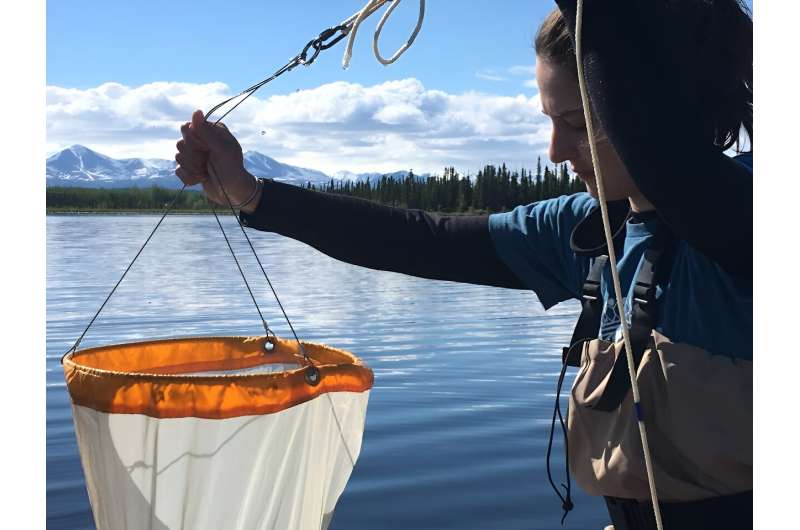Understanding how human activity impacts zooplankton is essential for managing and protecting lakewater

Freshwater ecosystems are impacted by human activities, including .
We are researchers at the Université du Québec à Montréal and part of the , a network of researchers across Québec who study lake ecosystems. We focus much of our research on zooplankton as they are such central food web players.
Zooplankton are a diverse group of microscopic animals that live in lakes, some large rivers and oceans. They are an essential central link in freshwater food webs and can act as first indicators of any impacts .
Dormant eggs
Zooplankton consist of several different groups, of which copepods and cladocerans are the two most studied. As crustaceans, both groups are covered in a hard exoskeleton or . Copepods have elongated bodies and can be herbivorous, omnivorous or carnivorous. They have complex life cycles and .
In contrast, cladocerans are generally more rounded, with bivalve carapaces and are more often herbivorous. They can reproduce both sexually and asexually, and .
Both copepods and cladocerans can produce dormant eggs—eggs that do not hatch right away—when the environmental conditions are unfavorable, . These eggs hatch later, when environmental conditions are suitable, such as in the spring.
However, many dormant eggs, rather than hatching, are instead buried in lake sediments each year, creating a historical record that can then be used to study how zooplankton populations potentially adapt to .
An important food source
Zooplankton can affect lake ecosystems in several ways. In part, this is because of their intermediate food web position between phytoplankton (microscopic algae), which primarily harness energy from the sun to produce food, and predators that depend on zooplankton as prey.
By feeding on phytoplankton, zooplankton help control algal abundance in lakes, . Algal blooms are of concern because they are sometimes harmful because , cause and create oxygen-poor zones in lakes .
Zooplankton are also an important food source for many organisms, including fish, insect larvae and aquatic birds. They transfer energy and resources , playing an important role in nutrient cycles .

Human impacts
The severity and nature of the impacts of multiple stressors on lakes will differ depending on the type of threat that a faces. It will also depend on other factors such as the lake's , geology and .
Ongoing research into these stressors, and how zooplankton respond to them, is essential for our ability to understand, predict and mitigate their impacts on freshwater ecosystems.
Pollution has been a major threat to freshwater ecosystems since the . Lakes can be polluted by many different types of contaminants, including pesticides, salt, microplastics and metals. These pollutants come from many different sources, such as agricultural practices, mining and industry and urban waste.
Different contaminants can have different effects on zooplankton. Salinization is a global issue, and occurs as a result of agriculture, mining . In colder climates, salinization is mainly caused by road salts leaching into .
Lake salinization reduces zooplankton abundance and diversity, impairing their functional roles in controlling algal abundance and as . This, in turn, reduces the energy and resource transfer by zooplankton, thereby leading to .
Another long-standing threat to freshwater zooplankton is eutrophication—an over-supply of nutrients essential to primary production, . In eutrophic lakes, zooplankton communities often shift towards smaller-bodied species that are less rich in phosphorus than larger species that .
This reduces the regulatory role of zooplankton, making them less efficient in controlling algal blooms, which are also strongly favored by the nutrient additions associated with eutrophication.
The impacts of climate change
Climate warming will also cause a shift towards smaller-bodied and faster-growing zooplankton through both direct effects on metabolic rates and through increased predation by fish, who prefer feeding on larger zooplankton, further decreasing their .
Because larger zooplankton are more efficient grazers of phytoplankton (algae) and given their , this shift reduces the efficiency of zooplankton in food web transfers in lakes.
Climate warming often accompanies other stressors, interacting with them in different ways. For example, , but on the .
The study of freshwater zooplankton and the effects that human actions have on their communities is essential to our understanding of lake functioning in our changing world. Zooplankton research is essential for the effective management of freshwaters because it helps us mitigate, restore or work with the impacts to lakes caused by human activity.
Provided by The Conversation
This article is republished from under a Creative Commons license. Read the .![]()


















